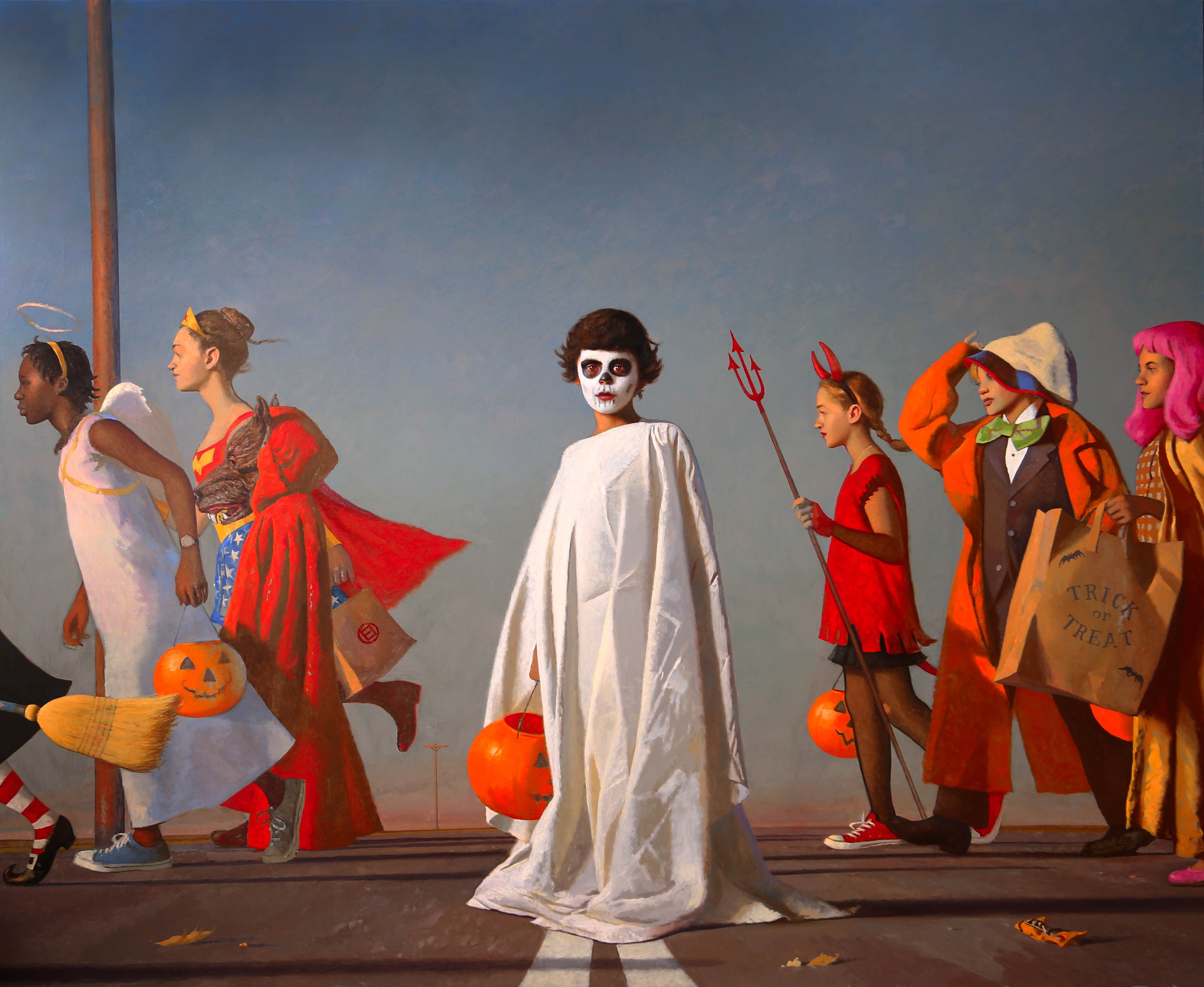/Bo Bartlett’s Halloween
A Journey of Masks
from 10/13/2024, by uni — 5m read

Figure 1: Bo Bartlett - Halloween (2016)
Bo Bartlett’s Halloween is a masterful exploration of the fleeting nature of life, the transition from childhood to adulthood, and the complex symbolism of wearing masks - both literal and metaphorical. At first glance, the painting presents a familiar scene: a group of children in Halloween costumes, marching in a line, bags in hand, ready for the ritualistic gathering of candy. But as you examine deeper, the painting reveals itself to be more than just a nostalgic snapshot of an American tradition; it becomes a meditation on individualism, isolation, and the subtle but inevitable passage of time.
The lighting in the painting, reminiscent of Edward Hopper’s work, is soft yet haunting, casting long shadows that suggest the encroaching dusk of both day and childhood. Hopper was known for his ability to convey a sense of solitude and quiet introspection through light, and Bartlett employs a similar technique here. The children are bathed in an otherworldly glow, emphasizing their vulnerability and the liminal space they inhabit between innocence and the awakening to life’s complexities.
Each child’s costume in Halloween tells its own story. From the angel to the superhero, the witch to the ghost, these personas reflect the archetypes and roles that children begin to adopt as they grow into themselves. At the heart of the composition is the ghost-child, painted with a skull-like face and draped in a white sheet. This figure draws immediate attention, not just for its central placement but for its aura of quiet self-awareness. The ghost-child no longer walks in lockstep with the others; instead, he turns to face the viewer, his gaze contemplative, as if he’s peering into his future. This moment feels like the instant when the child becomes conscious of the path he’s on, aware that it’s not just a game or a playful tradition, but the beginning of a much larger journey.
The ghost costume, traditionally simple and unassuming, takes on profound significance here. It represents not just the fleeting nature of childhood but also the looming reality of mortality. Childhood, like Halloween night, is temporary - a brief stage before the masks come off and the complexities of life set in. The ghost-child stands apart from the others, no longer able to blindly follow the road they walk. His mask, while physical, symbolizes the emotional and societal masks we all wear as we move through life. For him, this may be the moment when he realizes that the masks we wear aren’t just for play - they are shields, expressions of individuality, and at times, burdens.
In contrast to the ghost-child’s introspection, the other children continue forward, seemingly unaware of the existential weight hanging in the air. They are still bound to the innocence of childhood, marching ahead with their plastic pumpkins and costumes that shield them from the harsher realities of life. The witch, a classic Halloween figure, leads the group - a symbolic figure of rebellion and wisdom. Her role in this procession hints at deeper themes: the ways society pushes forward, guided by traditions and archetypes, yet always walking toward something darker, something more ambiguous.
This ambiguity is heightened by Bartlett’s deliberate choices in the painting’s composition. The apparent lack of houses, a hallmark of American suburbia, leaves the children wandering through a barren, disconnected landscape. Power lines hang in the background, but they are not connected, further emphasizing the lack of grounding or stability in this world. This absence of a clear destination or sense of home speaks to a broader theme of disconnection in American life. The suburban dream, often idealized, is here depicted as empty and incomplete. The children move through this space, but where are they headed? Bartlett leaves that question unanswered, allowing the viewer to ponder the isolation and ambiguity that lies beneath the surface of even the most familiar scenes.
In this way, Halloween is deeply American. It captures the ritualistic nature of suburban life - one where traditions like trick-or-treating are passed down from generation to generation - but also critiques it by exposing the empty spaces, the disconnection, and the inherent loneliness. The unconnected power lines and the barren street suggest that even in this moment of communal celebration, there is a fracture, a breakdown of connection, both physical and emotional.
And yet, this is not a painting of despair. While the ghost-child confronts the weight of the future, the others march forward, blissfully unaware, still protected by the innocence of their masks. For them, the costumes represent a momentary escape from the real world - they can embody angels, witches, superheroes, larger-than-life archetypes. But eventually, as the ghost-child realizes, the mask will come off, and they will have to face the world as themselves. In this moment, Bartlett challenges us to reflect on what lies beyond childhood’s illusions, as we transition from innocence to self-awareness. The painting ultimately invites us to consider the complexity of identity, the masks we wear throughout life, and the inevitable moment when we must confront who we truly are.